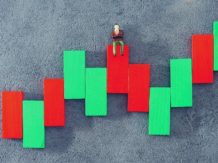Analyst Willy Woo shares many technical and fundamental analyses on Twitter. He has now developed a new indicator, the Bitcoin Difficulty Ribbon.
How hard can it be?
The ribbon consists of various moving averages of the difficulty level of mining. This model uses time scales from 9 to 200 days. In general, as the difficulty of mining increases, the 9-day moving average is usually higher than the 200-day moving average.
However, if the ribbon is compressed or even turned over, this may indicate that the difficulty is increasing less rapidly, or even that the difficulty is decreasing. Emilio Janus from Bitcoinist calls this moment the best time to buy bitcoin. That may seem like a very simple conclusion, so what’s behind this?
Introducing the Bitcoin Difficulty Ribbon. When the ribbon compresses, or flips negative, these are the best time to buy and get exposure to Bitcoin. The ribbon consists of simple moving averages on mining difficulty so we can easily see the rate of change in difficulty. pic.twitter.com/6kBz4sLG1d
– Willy Woo (@woonomic) August 1, 2019
Add the word to the deed
The whole idea behind this indicator is to see if there is a correlation, and perhaps even a causal relationship, between the difficulty of mines and the price of bitcoin. Miners receive bitcoin as a reward and part of it is sold to pay for energy, housing, lunch, depreciation of mining equipment, etc. This causes a downward pressure on the bitcoin price.
Miners with less computing power are less likely to find new blocks that they can add to the blockchain. They have to sell a larger part of their remuneration to remain operational. But this model is not tenable for much smaller miners; the moment a miner incurs more costs than receives rewards, it is only logical that they stop.
As a result, the amount of hashing power (computer power) decreases and this can lead to a reduction in the level of difficulty. And that can mean that only the big players stay afloat. And they have to sell a smaller part of their reward to be profitable. Less sales pressure leads to bullish sentiment, and this is an indicator of a rising price.
Above you see the reversal in the purple box, this is also the end of the bear market of 2018. The lack of sales pressure from smaller miners (who have left the market) ensures that the price can stabilize and rise.
You also see a similar effect during block halvings: from one moment to the next there is a decrease in pay and the offer, but the costs remain the same. Woo builds on work from 2014 by Vinny Lingham.
Looks like earlier bull market from 2012
Woo says that on the basis of this indicator the current bull market has more in common with that of 2012 than that of 2016. The ribbon was compressed in 2016, but the ribbon is completely reversed in both 2012 and 2019. In 2012 and 2019 you see a sharp decrease in the level of difficulty. This led to a greatly reduced sales pressure from miners and a shorter accumulation period before the price breaks out.
As a final note, notice how the 2019 the 2012 bull market have the same structure, we saw severe mining capitulation leading to a shorter accumulation band before price breakout. This bull market has resembles 2012 more than 2016 structurally. pic.twitter.com/qcRaZVdHTg
– Willy Woo (@woonomic) August 1, 2019
Difficulty of minen bitcoin, what about that again?
Every 2016 blocks (which translates to approximately two weeks) the difficulty level is automatically adjusted, the more miners (and therefore computer power) the higher the difficulty level. And the higher the level of difficulty, the lower the number to be found. Huh?
An example: imagine a table with a thousand cups.
- Underneath each cup is a note with a number between 1 and 1000. For the easiest difficulty level, ask a miner to find a number between 1 and 1000. He has already found it on his first attempt.
- We make something harder. He must find a number between 1 and 500. That’s a bit harder. A friend of the miner arrives and wants to participate. The two of them are now looking for a number between 1 and 500. Now it is becoming too easy again, they find the number very quickly.
- Out of the blue the bell rings and ten others want to participate. The system must now regulate itself to keep it exciting. Now they have to look for a number between 1 and 5.
A miner shoots a random number in an algorithm and that number (along with numbers coming from the previous block) is hashed to a result. That result must therefore be lower or equal to the level of difficulty. The miner only has influence by adjusting the number that he puts into the algorithm.
A thousand billion possibilities, one winner
In the example above, we assumed twelve numbers, with 1,000,000,000,000 (a thousand billion) of different options. The real bitcoin protocol uses SHA-256, or a series of 64 characters (equals 256 bits) that can consist of numbers and letters. You have to check how many options there are! To achieve one of these options, a miner must pass a number of eight decimal places through the algorithm.
At the same time, millions of miners are looking for the number that is lower than the difficulty level. The bitcoin protocol tries with the difficulty level to keep the average time that a block is found at ten minutes.
Is a miner the first to find a new block? Then the block with the associated transactions is added to the blockchain. The miner receives 12.5 bitcoin as a reward.















